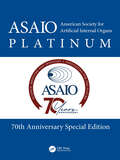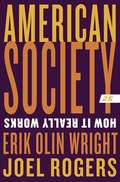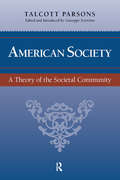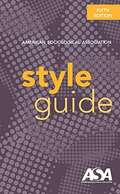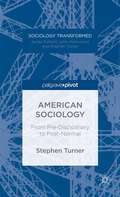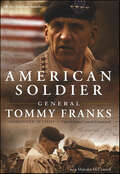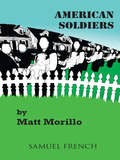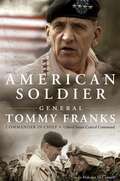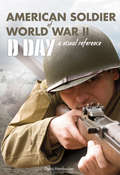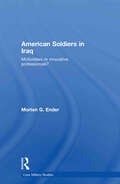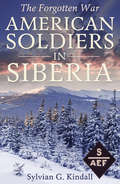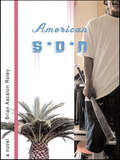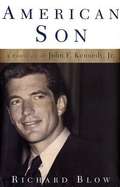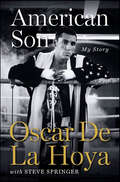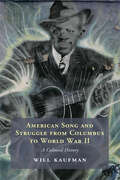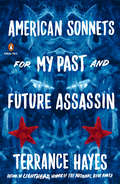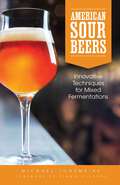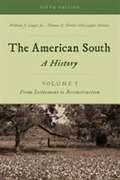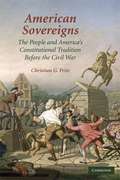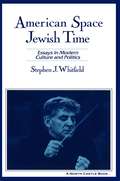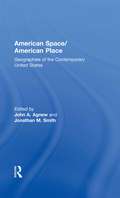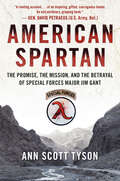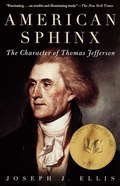- Table View
- List View
American Society for Artificial Internal Organs (ASAIO) Platinum 70th Anniversary Special Edition
by Pramod BondeThis book celebrates two decades of groundbreaking research published in the ASAIO Journal, marking significant advancements in artificial organs and circulatory support.The American Society for Artificial Internal Organs ASAIO Platinum 70th Anniversary book is a compilation of 50 of the top papers published in the ASAIO Journal over the last two decades that have contributed to the evolution of the field. The book includes tables listing the Top 100- cited, viewed, and downloaded, articles from the ASAIO Journal. It also lists the Top 10 Altmetric Scores by Year, 2015-2024. Topics range from artificial vision for the blind, and control systems for blood glucose, to the development of an artificial placenta IV and engineering 3D bio-artificial heart muscle, and much more. This book represents early ideas and concepts, new treatments and devices that changed future clinical care and some early concepts that challenge the status quo. With contributions from leading experts, the ASAIO 70th Anniversary Book serves as a comprehensive resource for anyone interested in the forefront of artificial organ technology and its impact on improving patient outcomes.This book is intended for clinicians, scientists, engineers, and academics working for the advancement and development of innovative medical device technologies.
American Society: How It Really Works (Second Edition)
by Joel Rogers Erik Olin WrightThe authors identify five core social values that most Americans affirm in one way or another: freedom, prosperity, efficiency, fairness, and democracy and challenge the effectiveness of the same.
American Society: Toward a Theory of Societal Community
by Talcott Parsons Giuseppe SciortinoNever before published, American Society is the product of Talcott Parsons' last major theoretical project. Completed just a few weeks before his death, this is Parsons' promised 'general book on American society'. It offers a systematic presentation and revision of Parson's landmark theoretical positions on modernity and the possibility of objective sociological knowledge. Even after the passage of many years, American Society imparts a remarkably provocative interpretation of US society and a creative approach to social theory.
American Sociological Association Style Guide
by American Sociological AssociationThe sixth edition of the ASA Style Guide is the authoritative reference for writing, submitting, editing, and copy editing manuscripts for ASA journals and other publications following ASA's unique format. This revised, updated edition features guidelines for the most common situations encountered by authors and editors. New features include revisions to reference formatting and additional information on grammar, as well as expanded information on the use of electronic , digital, and social media sources. The sixth edition also includes guidance for online manuscript submissions, preprints, and updated reference examples. Coil binding. 163 pages, March 2019.
American Sociological Association Style Guide (Fifth Edition)
by American Sociological AssociationThe ASA Style Guide highlights and features guidelines for the most common situations encountered by authors and editors in the ASA journal publication process. It is designed to serve as the authoritative reference for writing, submitting, editing, and copy editing manuscripts for ASA journals. The Guide also serves a wider community of researchers, writers, and pub¬lishers who use it to prepare and present scholarly papers in other sociological and social science venues.
American Sociology: From Pre-Disciplinary to Post-Normal
by Stephen TurnerAmerican Sociology has changed radically since 1945. This volume traces these changes to the present, with special emphasis on the feminization of sociology and the decline of the science ideal as well as the challenges sociology faces in the new environment for universities.
American Soldier
by Tommy R. Franks Malcolm McConnellTo America, he was a hero.To his troops, he was a soldier.Now hear his story.Each new era in American history has given rise to a military leader who defines the nation’s proudest traditions—of leadership and honor, of vision and commitment and courage in the face of any challenge. From Washington and U.S. Grant to Dwight D. Eisenhower and Norman Schwarzkopf, these men have captured the nation’s imagination, and entered the small pantheon of
American Soldier
by Matt MorilloDrama / Characters: 3m, 2f / In American Soldiers, the patriarch of a politically prominent Long Island family fights to hold the family together when his eldest daughter, an Army veteran, returns from the Middle East for an uneasy homecoming. The girl, emotionally scarred from her military service, is struggling to take her ex-boyfriend and sister away with her to start a new life in Colorado. Her aim is to liberate them of the hometown influences of society, religion and class that led her to enlist. The play reveals the urge of children to break away, the power of family destiny and the emotional ties that bind. What is it about Nassau and Suffolk counties that makes them a breeding ground for "good little American soldiers," as Angela Coletti, the returning veteran, says? Her late mother had been a local Assemblywoman and her brother, Carlo Jr., is now running for a congressional seat. They are liberal politicians and "modern" Catholics, chastened by the wars of our time, who would seem to hold the old beliefs at arms' length. But to Angela, they are no more than cogs in a machine of conformity whose morals make no sense and who perpetuate dangerous myths. The force of her rebellion is set against the determination of her father, a Vietnam Veteran who is equally committed to holding the family together. His methods range from the good old fatherly temper tantrum to the kind of heart-to-heart with his soldier-daughter that only veterans can have. Through their tug of war, we witness the real forces that keep many of our young people fighting what Angela calls, "the same fight, generation after generation." It's the power of family and the hold of religion.
American Soldier
by Tommy FranksThe autobiography of General Tommy Franks. A look at the war on terrorism from someone who served on the frontlines as both a warrior and a diplomat.
American Soldier of WWII: D-Day, A Visual Reference
by Denis HambuckenOn June 6, 1944, 75,000 American men landed on the beaches of Normandy. The opening act in the liberation of Western Europe was the most ambitious military operation in history. This book provides an intimate look at soldiers' day-to-day experience through period equipment, weapons, and personal belongings. American Soldier of World War II provides a detailed look at the lives, weapons, and equipment of the soldiers who fought in the European Theater through a collection of artifacts and exacting reproductions. While other books examine World War II from a political, tactical, or military perspective, this book focuses on the day-to-day life and the human experience of the American men who fought and often gave their lives to defeat fascism. Illustrated with full-color photographs and historical documents, engagingly written and thoroughly explained, this book is the perfect addition to children's and adults' library collections, school libraries, and the personal libraries of history buffs of all ages.
American Soldiers in Iraq: McSoldiers or Innovative Professionals? (Cass Military Studies)
by Morten G. EnderAmerican Soldiers in Iraq offers a unique snapshot of American soldiers in Iraq, analyzing their collective narratives in relation to the military sociology tradition. Grounded in a century-long tradition of sociology offering a window into the world of American soldiers, this volume serves as a voice for their experience. It provides the reader with both a generalized and a deep view into a major social institution in American society and its relative constituents-the military and soldiers-during a war. In so doing, the book gives a backstage insight into the U.S. military and into the experiences and attitudes of soldiers during their most extreme undertaking-a forward deployment in Iraq while hostilities are intense. The author triangulates qualitative and quantitative field data collected while residing with soldiers in Iraq, comparing and contrasting various groups from officers to enlisted soldiers, as well as topics such as boredom, morale, preparation for war, day-to-day life in Iraq, attitudes, women soldiers, communication with the home-front, "McDonaldization" of the force, civil-military fusion, the long-term impact of war, and, finally, the socio-demographics of fatalities. The heart of American Soldiers in Iraq captures the experiences of American soldiers deployed to Operation Iraqi Freedom at the height of the conflict in a way unprecedented in the literature to date. This book will be essential reading for students of military studies, sociology, American politics and the Iraq War, as well as being of much interest to informed general readers.
American Soldiers in Siberia
by Sylvian G. KindallAmerican Soldiers in Siberia by U.S. Army officer Sylvian G. Kindall (first published in 1945), recounts his experiences as a member of the American Expeditionary Force Siberia from 1918 to 1920. AEF Siberia was involved in the Russian Civil War in and around Vladivostok at the end of World War I following the October Revolution. The futility and unpreparedness of the mission is apparent throughout the book, as is the author’s intense disdain for the Japanese troops, who were witnessed in repeated acts of violence against an unarmed citizenry. President Woodrow Wilson’s claimed objectives for sending troops to Siberia were both diplomatic and military: (1) rescue the 40,000 men of the Czechoslovak Legions, who were being harassed by Bolshevik forces as they attempted to make their way along the Trans-Siberian Railroad to Vladivostok; (2) to protect the large quantities of military supplies and railroad rolling stock that the United States had sent to the Russian Far East in support of the prior Russian government’s war efforts on the Eastern Front; (3) the need to “steady any efforts at self-government or self defense in which the Russians themselves may be willing to accept assistance.” At the time, Bolshevik forces controlled only small pockets in Siberia and Wilson wanted to ensure that neither Cossack marauders nor the Japanese military would take advantage of the unstable political environment along the strategically important railroad line located in this resource-rich region. For similar reasons, about 5,000 American soldiers were also sent to Arkhangelsk (Archangel), Russia by President Wilson as part of the separate Polar Bear Expedition.
American Son: A Novel
by Brian Ascalon RoleyA powerful novel about ethnically fluid California, and the corrosive relationship between two Filipino brothers.Told with a hard-edged purity that brings to mind Cormac McCarthy and Denis Johnson, American Son is the story of two Filipino brothers adrift in contemporary California. The older brother, Tomas, fashions himself into a Mexican gangster and breeds pricey attack dogs, which he trains in German and sells to Hollywood celebrities. The narrator is younger brother Gabe, who tries to avoid the tar pit of Tomas's waywardness, yet moves ever closer to embracing it. Their mother, who moved to America to escape the caste system of Manila and is now divorced from their American father, struggles to keep her sons in line while working two dead-end jobs. When Gabe runs away, he brings shame and unforeseen consequences to the family. Full of the ache of being caught in a violent and alienating world, American Son is a debut novel that captures the underbelly of the modern immigrant experience.A Los Angeles Times Best Book, New York Times Notable Book, and a Kiriyama Pacific Rim Prize Finalist
American Son: A Portrait Of John F. Kennedy, Jr.
by Richard BlowAt thirty-four, better known for his social life than his work as an assistant district attorney, John F. Kennedy, Jr. , was still a man in search of his destiny. All that changed in 1995, when Kennedy launched a bold new magazine about American politics, puckishly called George. Over the next four years, Kennedy's passionate commitment to the magazine and to the ideals it stood for transformed him. One witness to this transformation was Richard Blow, an editor and writer who joined George several months before the release of its first issue. During their four years together, Blow observed his boss rise to enormous challenges starting a risky new business, managing the pressures that attend a high public profile, and beginning life as a married man. With Blow as our surrogate, we see the many sides of Kennedy's personality: the rebel who fearlessly takes on politicians and pundits; the gentleman who sends gracious thank-you notes to his colleagues for their wedding gifts; the vulnerable son occasionally at odds with a mythic family legacy; the leader who stays true to his vision, no matter how difficult the circumstances. Simply and sympathetically, Blow offers an affecting portrait of a complicated man at last coming into his own sometimes gracefully, sometimes under siege, but never without the burden of great expectations.
American Son: My Story
by Steve Springer Oscar De La HoyaFrom Oscar De La Hoya, one of the most celebrated fighters in the history of boxing, comes a frank and touching memoir about achieving the American Dream: his rise to the top, the power of a solid work ethic, his mother's painful death from cancer, the pitfalls of stardom, and a very personal take on what it means to be an American The son of Mexican-born parents, Oscar "The Golden Boy" De La Hoya has had an astonishing career. From boxing to business, from the recording industry to the charitable accomplishments of his foundation, his success is a testament to what one can achieve in the United States. But who is this man who has changed the lives of so many? Who has imprinted a positive mark upon the sport of boxing, for which many have all but given up hope? Who has become a symbol of success for an entire community, without many heroes to call their own?American Son answers these questions.Born into a boxing family, De La Hoya has defeated more than a dozen world champions and won six world titles as well as an Olympic gold medal—a moment forever marked in the memory of anyone who has followed his career. Yet within the maelstrom of this success lay a man whose earnest belief in the goodness of everyone around him sometimes led him to stray far from his intended path. This book is The Golden Boy, and he bares his most heartbreaking mistakes as well as his most stunning triumphs for all of the world to see. This thrilling tale of an immigrant's son—a quintessentially American story—is the chronicle of an amazing journey that will provide readers with new insight into the private life of a figure who has to many reached iconic status.
American Song and Struggle from Columbus to World War 2: A Cultural History
by Will KaufmanLong before anyone ever heard of 'protest music', people in America were singing about their struggles. They sang for justice and fairness, food and shelter, and equality and freedom; they sang to be acknowledged. Sometimes they also sang to oppress. This book uncovers the history of these people and their songs, from the moment Columbus made fateful landfall to the start of the Second World War, when 'protest music' emerged as an identifiable brand. Cutting across musical genres, Will Kaufman recovers the passionate voices of America itself. We encounter songs of the mainland and the conquered territories of Hawai'i, Cuba, Puerto Rico, and the Philippines; we hear Indigenous songs, immigrant songs and Klan songs, minstrel songs and symphonies, songs of the heard and the unheard, songs of the celebrated and the anonymous, of the righteous and the despicable. This magisterial book shows that all these songs are woven into the very fabric of American history.
American Sonnets for My Past and Future Assassin (Penguin Poets)
by Terrance HayesA powerful, timely, dazzling collection of sonnets from one of America's most acclaimed poets, Terrance Hayes, the National Book Award winning author of Lighthead <P><P>"The right poetry collection for right now." - The Los Angeles Times <P><P>In seventy poems bearing the same title, Terrance Hayes explores the meanings of American, of assassin, and of love in the sonnet form. <P><P>Written during the first two hundred days of the Trump presidency, these poems are haunted by the country's past and future eras and errors, its dreams and nightmares. <P>Inventive, compassionate, hilarious, melancholy, and bewildered--the wonders of this new collection are irreducible and stunning.
American Sour Beer: Innovative Techniques for Mixed Fermentations
by Michael TonsmeireOne of the most exciting and dynamic segments of today&’s craft brewing scene , American-brewed sour beers are designed intentionally to be tart and may be inoculated with souring bacteria, fermented with wild yeast or fruit, aged in barrels or blended with younger beer. Craft brewers and homebrewers have adapted traditional European techniques to create some of the world&’s most distinctive and experimental styles. This book details the wide array of processes and ingredients in American sour beer production, with actionable advice for each stage of the process. Inspiration, education and practical applications for brewers of all levels are provided by some of the country&’s best known sour beer brewers.
American South: A History
by William J. Cooper Christopher Childers Thomas E. TerrillIn The American South: A History, Fifth Edition, William J. Cooper, Jr. and Thomas E. Terrill demonstrate their belief that it is impossible to divorce the history of the South from the history of the United States. The authors' analysis underscores the complex interaction between the South as a distinct region and the South as an inescapable part of America. Cooper and Terrill show how the resulting tension has often propelled section and nation toward collision. <P><P> In supporting their thesis, the authors draw on the tremendous amount of profoundly new scholarship in Southern history. Each volume includes a substantial bibliographical essay--completely updated for this edition--which provides the reader with a guide to literature on the history of the South. This volume contains updated chapters, and tables.
American Sovereigns: The People and America's Constitutional Tradition Before the Civil War
by Christian FritzAmerican Sovereigns is a path-breaking interpretation of America's political history and constitutionalism that explores how Americans struggled over the idea that the people would rule as the sovereign after the American Revolution. National and state debates about government action, law, and the people's political powers reveal how Americans sought to understand how a collective sovereign--the people--could both play the role as the ruler and yet be ruled by governments of their own choosing.
American Space, Jewish Time
by Stephen J. Whitfield"This is a delightful book, a small gem replete with insightful, provocative pieces about both American culture and Jewish life. I think that Stephen Whitfield is one of the most original essayists on these two topics. Few other scholars combine the density of his knowledge with the verve of his prose". -- Hasia R. Diner, New York University
American Space/American Place: Geographies of the Contemporary United States
by John A. Agnew Jonathan M. SmithAmerican Space/American Place offers geographical perspectives on the condition of the United States at the outset of the twenty-first century. It compares the American ideal of liberty, equality, individual opportunity and social improvement with the contemporary condition of the regions, states and localities--the ideal American space with its reality as a place. It uses the public standard provided by the official ideology of the United States to see how well things are really going. Agnew and Smith consider the contrast between ideal and reality at local, state and national levels in education, health, and welfare, in community, race, gender, and calss relations, in economic and industrial development, and in the use and exploitation of America's landscape. American Space/American Place provides a series of compelling insights into the current condition of American Society, its natural environment and its place within the world.
American Spartan: The Promise, the Mission, and the Betrayal of Special Forces Major Jim Gant
by Ann Scott TysonA gripping account of a U.S. Army Special Forces major’s journey into the tribal Pashtuns of Afghanistan by a Pulitzer Prize–nominated author.One of the most charismatic, controversial U.S. commanders of modern memory, Army Special Forces Major Jim Gant changed the face of America’s war in Afghanistan when his critical white paper, “One Tribe at a Time,” went viral at the Pentagon, the White House, and on Capitol Hill in 2009.A decorated Green Beret who had spent years training indigenous fighters, Jim argued for embedding autonomous units with tribes across Afghanistan: these American soldiers would live among Afghans for extended periods, not only to train tribal militias but also to fight with them in battle. He argued that these small U.S. teams could earn the trust of the Afghans and transform them into reliable allies with whom we could defeat the Taliban and Al Qaeda networks.Correspondent Ann Scott Tyson came to share Jim’s vision that Americans and Pashtuns could fight side-by-side and create real change across the region, so she accompanied him to Afghanistan. This remarkable story—of Jim’s close relationships with village elder Noor Afzhal, the fierce fighting they took straight to the enemy in the mountains of Konar Province, and Ann and Jim’s deepening love for each other—is told with a keen sense of drama and immediacy.A story like no other, American Spartan is one of the most remarkable and emotionally resonant narratives of war ever published.
American Speeches: Political Oratory from Abraham Lincoln to Bill Clinton
by Ted WidmerFrom the book: Public speeches have profoundly shaped American history and culture, transforming not only our politics but also our language and our sense of national identity. This volume collects the unabridged texts of 83 eloquent and dramatic speeches delivered by 45 American public figures between 1865 and 1997, beginning with Abraham Lincoln's last speech on Reconstruction and ending with Bill Clinton's heartfelt tribute to the Little Rock Nine. During this period American political oratory continued to evolve, as a more conversational style, influenced by the intimacy of radio and television, emerged alongside traditional forms of rhetoric. Included are speeches on Reconstruction by Thaddeus Stevens and African-American congressman Robert Brown Elliott, Frederick Douglass's brilliant oration on Abraham Lincoln, and Oliver Wendell Holmes's "touched with fire" Memorial Day Address. Speeches by Robert Ingersoll and William Jennings Bryan capture the fervor of 19th-century political conventions, while Theodore Roosevelt and Carl Schurz offer opposing views on imperialism. Ida B. Wells and Mary Church Terrell denounce the cruelty of lynching and the injustice of Jim Crow; Susan B. Anthony, Elizabeth Cady Stanton, and Carrie Chapman Catt advocate the enfranchisement of women; and Woodrow Wilson and Henry Cabot Lodge present conflicting visions of the League of Nations. Also included are wartime speeches by George Patton and Dwight Eisenhower; an address on the atomic bomb by J. Robert Oppenheimer; Richard Nixon's "Checkers Speech"; Malcolm X's "The Ballot or the Bullet"; Barry Goldwater's speech to the 1964 Republican convention; Mario Savio urging Berkeley students to stop "the machine"; Barbara Jordan defending the Constitution during Watergate; and an extensive selection of speeches by Franklin Roosevelt, Martin Luther King, John F. Kennedy, and Ronald Reagan. Ted Widmer, editor, is t
American Sphinx: The Character of Thomas Jefferson (American History Ser.)
by Joseph J. EllisFor a man who insisted that life on the public stage was not what he had in mind, Thomas Jefferson certainly spent a great deal of time in the spotlight--and not only during his active political career. After 1809, his longed-for retirement was compromised by a steady stream of guests and tourists who made of his estate at Monticello a virtual hotel, as well as by more than one thousand letters per year, most from strangers, which he insisted on answering personally. In his twilight years Jefferson was already taking on the luster of a national icon, which was polished off by his auspicious death (on July 4, 1826); and in the subsequent seventeen decades of his celebrity--now verging, thanks to virulent revisionists and television documentaries, on notoriety--has been inflated beyond recognition of the original person.<P><P> For the historian Joseph J. Ellis, the experience of writing about Jefferson was "as if a pathologist, just about to begin an autopsy, has discovered that the body on the operating table was still breathing." In American Sphinx, Ellis sifts the facts shrewdly from the legends and the rumors, treading a path between vilification and hero worship in order to formulate a plausible portrait of the man who still today "hover[s] over the political scene like one of those dirigibles cruising above a crowded football stadium, flashing words of inspiration to both teams." For, at the grass roots, Jefferson is no longer liberal or conservative, agrarian or industrialist, pro- or anti-slavery, privileged or populist. He is all things to all people. His own obliviousness to incompatible convictions within himself (which left him deaf to most forms of irony) has leaked out into the world at large--a world determined to idolize him despite his foibles.<P> From Ellis we learn that Jefferson sang incessantly under his breath; that he delivered only two public speeches in eight years as president, while spending ten hours a day at his writing desk; that sometimes his political sensibilities collided with his domestic agenda, as when he ordered an expensive piano from London during a boycott (and pledged to "keep it in storage"). We see him relishing such projects as the nailery at Monticello that allowed him to interact with his slaves more palatably, as pseudo-employer to pseudo-employees. We grow convinced that he preferred to meet his lovers in the rarefied region of his mind rather than in the actual bedchamber. We watch him exhibiting both great depth and great shallowness, combining massive learning with extraordinary naïveté, piercing insights with self-deception on the grandest scale. We understand why we should neither beatify him nor consign him to the rubbish heap of history, though we are by no means required to stop loving him. He is Thomas Jefferson, after all--our very own sphinx.<P> Winner of the National Book Award
